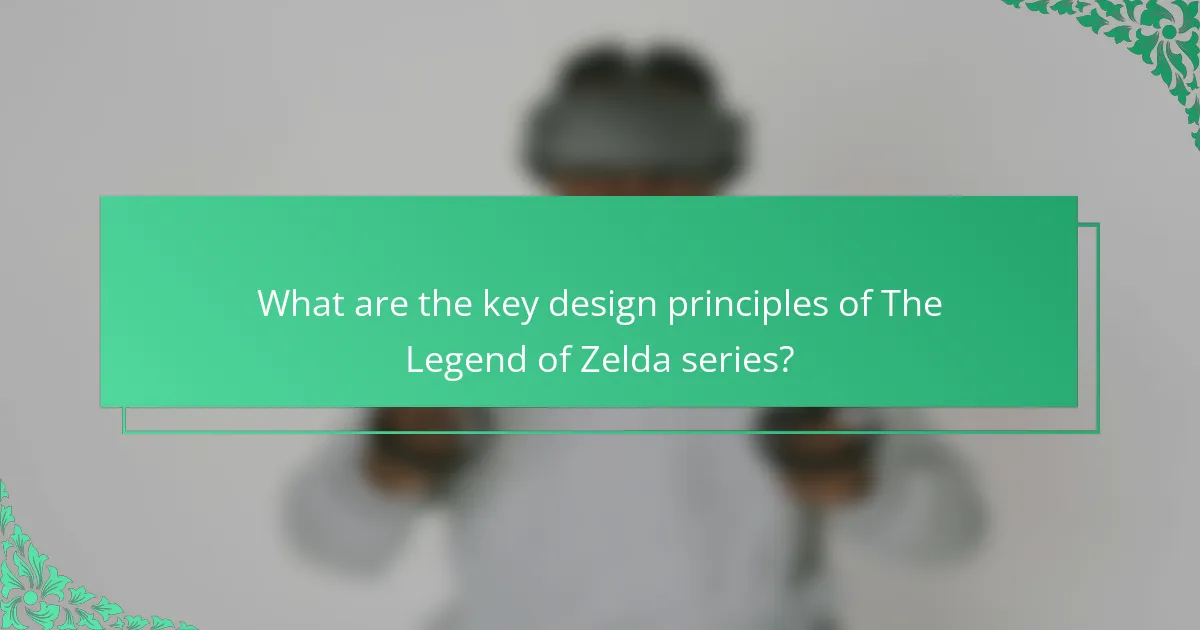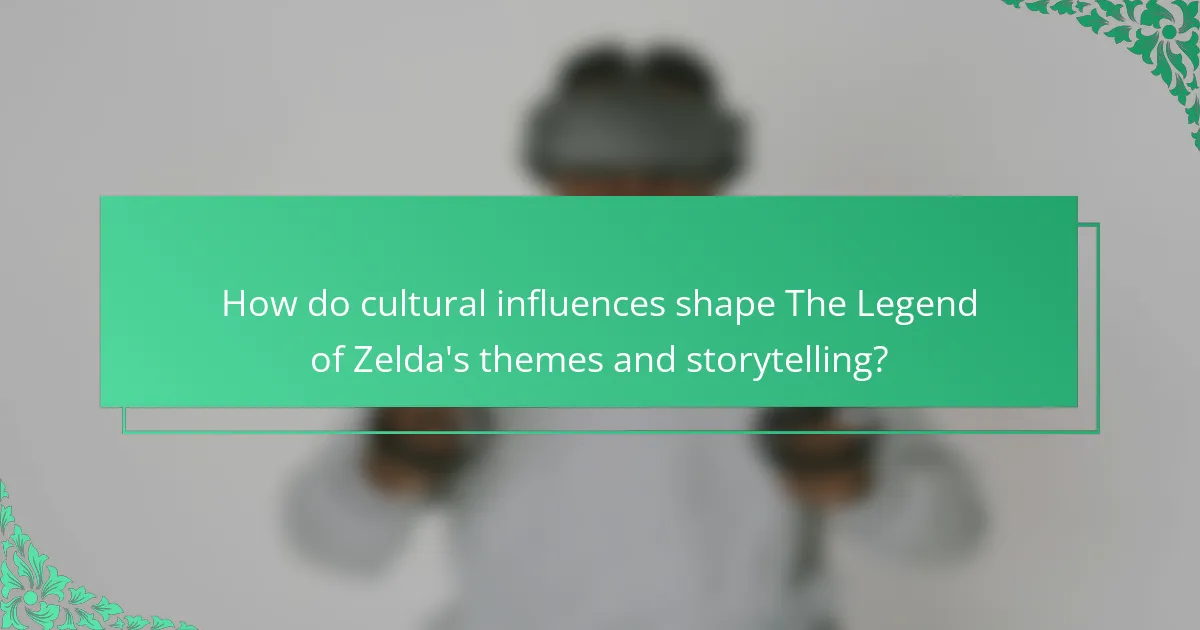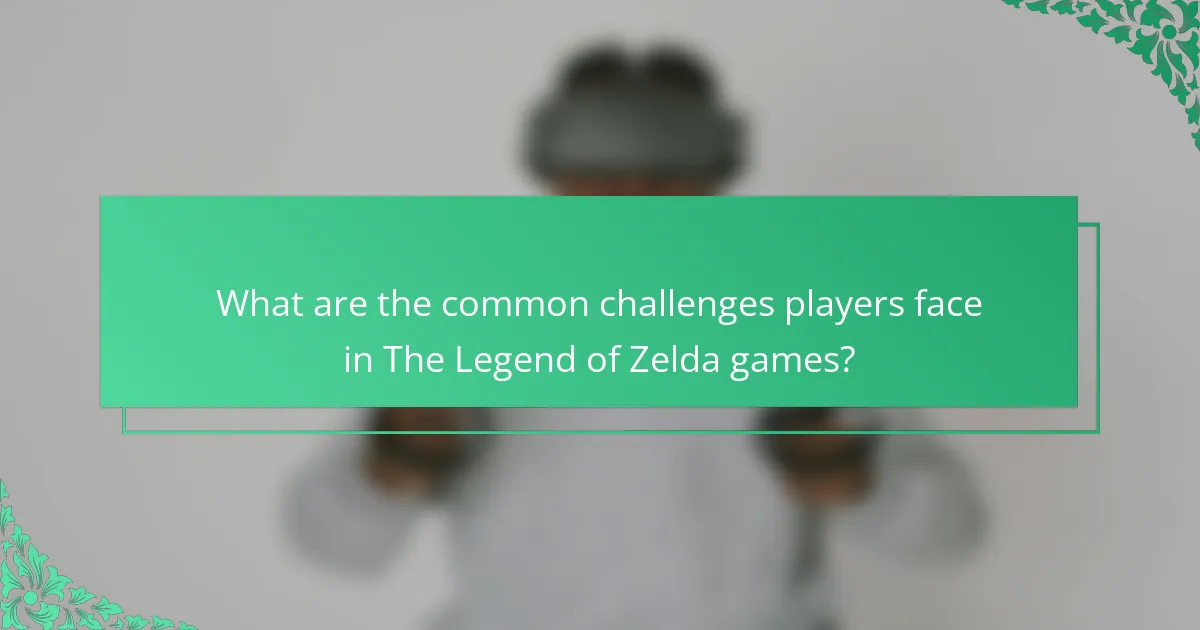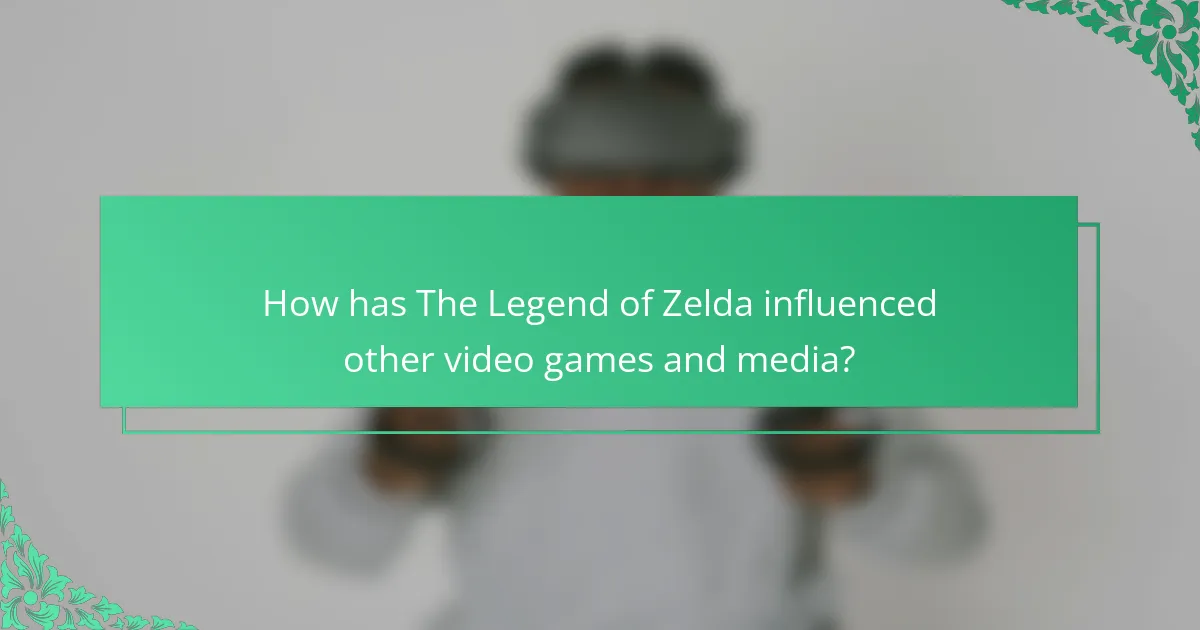The Legend of Zelda series captivates players with its innovative game design, rich storytelling techniques, and iconic items. Key design principles include exploration, puzzle-solving, and player agency. The evolution of storytelling introduces deeper narratives and character development. Iconic items like the Master Sword and Hylian Shield enhance gameplay while reflecting the series’ themes.

What are the key design principles of The Legend of Zelda series?
The key design principles of The Legend of Zelda series include exploration, puzzle-solving, and player agency. These elements create immersive gameplay experiences that encourage creativity and critical thinking.
Exploration is central to the series, allowing players to discover vast worlds filled with secrets. Puzzle-solving challenges players to think strategically, often utilizing unique items to progress. Player agency empowers individuals to make choices that affect their journey, enhancing engagement.
The series also emphasizes storytelling through environmental narrative and character development, enriching the overall experience. Iconic items, such as the Master Sword and Hylian Shield, serve as essential tools that embody the game’s themes and mechanics.
These design principles collectively establish The Legend of Zelda as a pioneering franchise in the gaming industry.
How does gameplay mechanics enhance player engagement?
Gameplay mechanics significantly enhance player engagement by providing interactive challenges, rewarding exploration, and fostering emotional connections. In “The Legend of Zelda,” mechanics like puzzle-solving and combat create a dynamic environment that encourages players to immerse themselves in the story. Unique items, such as the Master Sword, serve as pivotal tools that deepen player investment and satisfaction. As a result, these elements contribute to a rich gaming experience that keeps players returning.
Which visual styles define the series across different titles?
The visual styles across different titles in “The Legend of Zelda” series are defined by vibrant colors, unique character designs, and distinct environments. The series utilizes cel-shading in “The Wind Waker,” creating a cartoon-like aesthetic. In contrast, “Breath of the Wild” employs a more realistic art style with expansive landscapes and detailed textures. Each title showcases a unique visual identity while maintaining core thematic elements, such as adventure and exploration. The evolution of these styles reflects advancements in technology and design philosophy, enhancing the overall player experience.

How does storytelling evolve throughout The Legend of Zelda games?
Storytelling in The Legend of Zelda games evolves by integrating deeper narratives and complex character arcs. Initially, the series emphasized simple quests and archetypal characters. Over time, it introduced intricate storylines, emotional depth, and player choices that impact the journey.
For instance, The Legend of Zelda: Ocarina of Time featured a dual timeline, enhancing the lore significantly. In contrast, Breath of the Wild focused on an open-world experience, allowing players to uncover the story at their own pace, blending exploration with narrative.
The series consistently utilizes iconic items, like the Master Sword, to connect gameplay with storytelling. Each game builds on established lore, enriching the overall narrative while maintaining core themes of courage, wisdom, and power.
This evolution reflects a commitment to storytelling that resonates with players, fostering a deeper emotional connection to the game world.
What narrative techniques are employed to create immersive experiences?
The Legend of Zelda employs various narrative techniques to create immersive experiences. Techniques include environmental storytelling, character development, and interactive gameplay that engages players emotionally. Environmental storytelling uses visual cues to convey lore and history, enhancing the game’s world. Character development allows players to form connections with iconic characters, driving emotional investment. Interactive gameplay encourages exploration and decision-making, making players feel integral to the story. These elements combine to create a rich narrative tapestry that captivates players throughout their journey.
How do character arcs contribute to the overall story?
Character arcs significantly enhance storytelling by providing depth and emotional resonance. In “The Legend of Zelda,” character growth influences player engagement and plot progression. For example, Link’s evolution from a silent protagonist to a hero with depth allows players to connect with his journey. This transformation creates an immersive experience, making the narrative more compelling. Additionally, character arcs often reflect themes of courage and friendship, reinforcing the game’s core messages. Ultimately, well-crafted arcs contribute to a richer, more cohesive story.
![]()
What iconic items are featured in The Legend of Zelda, and what are their functions?
The Legend of Zelda features iconic items like the Master Sword, Hylian Shield, and Triforce, each with unique functions. The Master Sword serves as a powerful weapon against evil, the Hylian Shield provides defense against attacks, and the Triforce represents ultimate power, wisdom, and courage. Other notable items include bombs for destruction, arrows for ranged attacks, and potions for health restoration. Each item enhances gameplay and deepens the narrative experience.
How do items enhance gameplay strategy and exploration?
Items significantly enhance gameplay strategy and exploration in The Legend of Zelda by providing unique abilities and tools. Each item, such as the Hookshot or Bombs, allows players to access new areas and solve puzzles. This design encourages experimentation and strategic planning. For example, using the Boomerang to stun enemies creates opportunities for exploration without direct confrontation. Items also introduce varied gameplay mechanics, making each encounter unique and engaging. Overall, the thoughtful integration of items fosters a deeper connection between players and the game world.
Which items are unique to specific games in the series?
Unique items in “The Legend of Zelda” series include the Master Sword, Hylian Shield, and Triforce. Each game features items that enhance gameplay and storytelling. For instance, the Hookshot appears in multiple titles but is uniquely utilized in “Ocarina of Time” for puzzle-solving. The Boomerang is iconic in “The Wind Waker,” showcasing its unique ability to return to the player after being thrown. Additionally, the Spirit Orb in “Breath of the Wild” provides unique gameplay mechanics by enhancing health and stamina.

How do cultural influences shape The Legend of Zelda’s themes and storytelling?
Cultural influences significantly shape The Legend of Zelda’s themes and storytelling through mythology, folklore, and historical contexts. The series draws from various cultures, particularly Japanese and Western influences, enriching its narrative depth.
For example, the hero’s journey reflects universal themes seen in global mythology, such as the quest for identity and the battle between good and evil. The incorporation of Shinto beliefs and Japanese folklore introduces unique elements, like the spiritual connection to nature and the presence of kami, which enhance the game’s lore.
Additionally, the portrayal of characters, such as Link and Zelda, embodies archetypal roles found in many cultures, showcasing bravery, wisdom, and sacrifice. These attributes resonate with players, making the narrative relatable across different cultural backgrounds.
The blend of these influences fosters a rich storytelling experience, allowing players to engage with the game on multiple levels, from personal reflection to cultural exploration.
What role does mythology play in the narrative structure?
Mythology significantly enhances the narrative structure of “The Legend of Zelda” by providing a rich backdrop and deep symbolism. It shapes character motivations, plot progression, and world-building, creating a cohesive experience. The game incorporates mythological themes such as heroism, quests, and the battle between good and evil, which resonate with players. This connection to mythology enriches the storytelling, making it more engaging and relatable. The unique attribute of intertwining gameplay with mythological elements sets “The Legend of Zelda” apart in the gaming landscape.
How is the concept of heroism portrayed differently in various titles?
Heroism in “The Legend of Zelda” is portrayed through the protagonist’s journey, emphasizing courage, selflessness, and growth. Different titles showcase unique aspects of heroism, from Link’s unwavering determination in “Ocarina of Time” to the collaborative spirit in “Breath of the Wild.” Each game presents heroism as a multifaceted concept, influenced by the environment and challenges faced. The narrative depth and character development reinforce the idea that heroism is not just about strength, but also about resilience and sacrifice.

What are the community’s favorite fan theories about The Legend of Zelda?
The community’s favorite fan theories about The Legend of Zelda often explore connections between games, characters, and timelines. Popular theories include the interpretation of Link as a reincarnation of the hero, the timeline’s complex branching paths, and the idea that the games represent different iterations of the same story. Fans frequently discuss the significance of iconic items like the Triforce and Master Sword in these theories, linking them to deeper narrative themes. Another compelling theory suggests that certain characters, such as Tingle, represent hidden aspects of the game’s lore. These theories enrich the gaming experience and foster community engagement.
How do fan interpretations enhance the understanding of the lore?
Fan interpretations deepen the understanding of the lore by providing diverse perspectives and insights. They encourage community engagement and foster discussions that explore hidden meanings and connections within the game’s narrative. This collective analysis often reveals unique attributes of characters and events, enhancing the overall appreciation of the story. Additionally, fan theories can inspire developers, leading to richer storytelling techniques in future installments.
Which theories have gained significant traction among fans?
Theories that have gained significant traction among fans of The Legend of Zelda include the Hero’s Journey, cyclical timelines, and the Triforce’s symbolism. Fans often discuss the Hero’s Journey as a framework for Link’s character development. The cyclical timelines theory suggests that the series’ events repeat across different eras, creating a rich lore. Additionally, the Triforce represents power, wisdom, and courage, influencing character motivations and conflicts throughout the franchise. These theories enhance the understanding of game design and storytelling techniques in the series.

What are the common challenges players face in The Legend of Zelda games?
Players in The Legend of Zelda games commonly face challenges such as intricate puzzles, time management in quests, and resource gathering. The game design often requires critical thinking and exploration, leading to frustration when players encounter difficult obstacles. Iconic items, like the Master Sword, can also present unique challenges in mastering their use. Additionally, storytelling techniques may create emotional stakes that complicate player decisions.
How do difficulty levels vary between different titles?
Difficulty levels in “The Legend of Zelda” vary significantly between titles, affecting player experience and engagement. For example, “Breath of the Wild” offers an open-world experience with dynamic challenges, while “Ocarina of Time” features structured dungeons with specific puzzles. Each title employs unique design elements that cater to different skill levels, enhancing accessibility and replayability. The balance between challenge and exploration remains a core design philosophy across the series.
What strategies can players use to overcome common obstacles?
Players can overcome common obstacles in The Legend of Zelda by utilizing strategic approaches. First, mastering the game mechanics enhances problem-solving skills. Players should explore thoroughly to uncover hidden items and paths. Additionally, leveraging iconic items, such as the Hookshot or Bombs, can provide unique solutions to puzzles. Collaborating with NPCs for hints can also reveal critical information. Finally, practicing patience and persistence helps players navigate challenging sections effectively.

How has The Legend of Zelda influenced other video games and media?
The Legend of Zelda has profoundly influenced video games and media through its innovative game design, storytelling techniques, and iconic items. Its open-world exploration and puzzle-solving mechanics set a standard for adventure games.
Many titles adopted the non-linear gameplay structure pioneered by The Legend of Zelda, allowing players to choose their paths. The series introduced memorable items like the Master Sword and Triforce, which have become cultural symbols in gaming.
Storytelling in The Legend of Zelda often blends epic quests with character development, inspiring narrative depth in subsequent games. The use of music and sound design also elevated emotional engagement, influencing multimedia storytelling across various platforms.
Overall, The Legend of Zelda’s impact is evident in diverse genres, shaping game mechanics, narrative approaches, and cultural references in the gaming industry and beyond.
What design elements have been adopted by other franchises?
Other franchises have adopted various design elements from The Legend of Zelda, focusing on exploration, puzzle-solving, and narrative depth. Franchises like Dark Souls emphasize challenging gameplay and environmental storytelling, while games like Hollow Knight incorporate intricate world design and interconnected areas. Additionally, franchises such as God of War have integrated epic narratives and character development, echoing Zelda’s storytelling techniques. These elements illustrate how Zelda’s influence extends across genres, shaping game design and player engagement.
How does The Legend of Zelda’s impact extend beyond gaming?
The Legend of Zelda’s impact extends beyond gaming through its influence on storytelling, design innovation, and cultural significance. The series revolutionized game design with its open-world exploration, allowing players to engage in non-linear gameplay. Its storytelling techniques, including rich lore and character development, have set a benchmark for narrative depth in video games. Iconic items, such as the Master Sword and Triforce, have become symbols in popular culture, transcending the gaming community. Additionally, the franchise has inspired various media adaptations, including animated series and merchandise, further solidifying its legacy across different platforms.
What are best practices for new players entering The Legend of Zelda series?
To succeed as a new player in The Legend of Zelda series, focus on exploration, puzzle-solving, and mastering combat mechanics. Embrace the open-world design that encourages discovery.
Familiarize yourself with iconic items like the Master Sword and the Hylian Shield, as they are crucial for progression. Pay attention to NPCs, as they often provide valuable hints and lore.
Practice patience in solving puzzles; many require observation and experimentation. Save frequently to avoid losing progress, especially before challenging encounters.
Engage with the community through forums and guides for tips and strategies, enhancing your gameplay experience.


